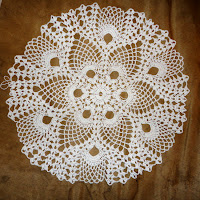(Sorry, to say, I still haven't replaced camera broken by said child, so terrible (stupid)phone photo will have to suffice.)
This garment is suitable for beginners, so enjoy!
MATERIALS:
Color A: Bernat Softee Baby Soft Fern
(1 skein)
Color B: Caron Simply Soft Light Real
Red (Just a little)
Color C: Bernat Softee Baby Antique
White (1 skein)
Hook sizes G6 and H8
Yarn needle.
GAUGE: 10 rows and 16 st = 4” in BLO
dc.
This dress does have 2 seams, but it is
NOT hard to piece them. Directions are for a 4T dress; it is easy to
customize and adjust for a larger size.
FRONT AND BACK: Using G6 hook, work two
identical pieces using the following.
Work in Color A. Ch 80.
ROW 1: Working in back ridge of
starting chain, dc in 4th chain from hook, dc in each ch
across. (78 dc) Turn.
ROW 2: ch 3 (counts as first dc), sk
1st dc, dc in BACK LOOP ONLY of each dc across (78 dc)
Turn.
Now is a good time to test for length.
If measuring on a person, hold the swatch slightly above armpit
height. Keep in mind that the bottom edging will add around 2" and that its weight will pull the dress down. If you need to add length, frog and increase the number of
stitches in the starting chain.
ROWS 3-28: Repeat row 2.
[For larger sizes, add length by
increasing starting chain. Any number of stitches is acceptible. Do
remember that the eventual weight of the edging on the bottom will
cause the dress to hang a little longer than it appearsat this
stage. For adding width, add an even number of rows. Easy peasy.]
When your rectangle is the desired
length and width to fit comfortably around the belly, it's time to
cinch the top. To do this:
Turn the work so that the ribs run
vertically. Ch 1. Work 1 sc around the post of the top dc in each of
the 28 rows (28 sc)
 |
| Before cinching. (FYI: This is just a swatch.) |
 |
| After cinching. (Still just a swatch.) |
JOIN COLOR B (red)
ROWS 29-30 (or whatever): ch 1, sc in
each sc across (28sc). Finish off.
With right sides together, sew front to
back in color A. Leave 8 stitches unsewn for arm holes!
COLLAR:
NOTE: Even though
this is now a round pattern, you will turn at the end of each row.
This will help hide the seam in the middle of the back.
Attach color C
with sl st in middle of back panel.
ROW 1: sc in each
sc to edge of panel (14 sc), ch 25, sc in ea sc across front panel
(28 sc), ch 25, sc in ea sc to start of round, join with sl st. Turn. [For a larger size, don't forget to increase the number of chains in the arm holes.]
ROW 2: ch 2
(counts as hdc), hdc in sc BEHIND your chain, creating a crossed
stitch effect. (Sk next unworked st, hdc in next st, hdc in skipped
st.) around.
ROWS 3-6 will
follow this same basic pattern, but you will work a DECREASE stitch
at the beginning and end of each arm hole. To DECREASE your row, do
this:
As you approach
the arm hole, (sk 2 st, hdc in next st, hdc in first skipped stitch)
twice, then continue in pattern. As you reach the other side of the
arm hole, repeat. [This is flexible. Depending on your yarn and
desired fit, you may wish to decrease only once. For a boatneck fit,
decrease once per joint (4 decreases total); for a fit that resembles
straps, decrease twice per joint (8 decreases total).
ROW 7: Join color
B. sc in each st across.
BOTTOM EDGING:
Switch to H8 hook.
ROW 1: Using COLOR
A: 3sc per row around base of dress, spaced evenly.
ROW 2: JOIN COLOR
B: sc in each sc around. Join with sl st. Turn.
ROW 3: ch 1, sc in
each sc around. TURN.
JOIN COLOR C.
ROW 4: ch 2, hdc
in same st as join, (2 hdc in each sc) around. Join with sl st. Turn.
ROW 5: ch 2, hdc
in st BEHIND your chain, creating crossed stitch effect. (sk next
unworked st, hdc in next st., hdc in skipped stitch) around. Join
with sl st. Turn.
ROW 6: ch 3, dc in
st BEHIND your chain, creating crossed stitch effect. (sk next
unworked st, dc in next st, dc in skipped st) around. Join with sl
st. Turn.
ROW 7: Repeat row
6. Finish off.
EDGING ALONG ARMS.
ROW 1: Join COLOR
C at back. Sc in ea st across (25 sc)
ROW 2: ch 3, sk 3
st, 4dc in next st, (sk 3 st, 5dc in next st –shell made) 6 times.
ROW 3: (ch 3,
picot, ch 2, sl st in center st of next shell) 5 times. Finish off.
Repeat for other arm.
Picot= ch 3, sl in
1st ch of picot. Practically, this means you will ch 6, sl
st in 4th ch from hook, ch 2, sl st in center of next
shell, repeat.
IF YOU WANT, you
can use the tail of the edging to cinch the arms to the body of the
dress. This can help create a boatneck look.



































